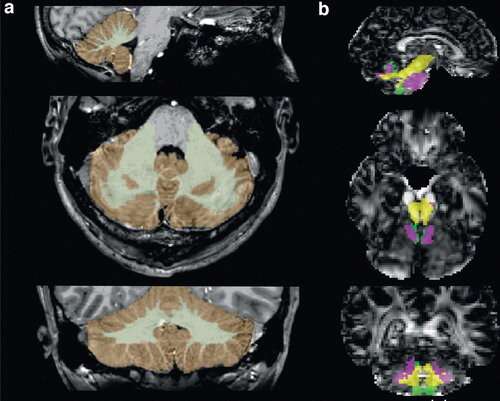Volumetrics, diffusion tensor imaging (DTI) and diffusion kurtosis imaging (DKI) of the cerebellum. Sagittal (upper row), axial (middle row), and coronal (lower row) views of the cerebellum are shown. (a) Cerebellar segmentation. Visualization of the performance of semi-automatic FreeSurfer approach for cerebellar white matter and gray matter segmentation. White matter is depicted with yellow color and gray matter with brown color. (b) Segmentation of white matter cerebellar tracts. Visualization of the performance of TractSeg in DKI. The superior cerebellar tract is depicted in yellow, the middle cerebellar tract in purple, and the inferior cerebellar tract in green. The cerebellar tracts are depicted on top of the fractional anisotropy image. A similar segmentation of the cerebellar tracts was also performed with TractSeg in DTI. Credit: Journal of Neurotrauma (2022). DOI: 10.1089/neu.2021.0447
Many professional athletes who have sustained head trauma in sports have lingering symptoms that affect everyday life, including depression, dizziness, difficulty focusing the gaze and balance problems. Little help has been available as the cause has been unknown. A clinical study from Lund University in Sweden can now show that the problems originate in an injury to the vestibular nerve.
Athletes in contact sports such as ice hockey, football and skiing have an increased risk of sustaining a head injury. If the impact is severe enough, the athlete can suffer a concussion. Even minor head injuries can have serious consequences. The problems have been brought to light within American football, where players who have suffered from repeated concussions have developed dementia, severe depression and cognitive impairment.
In many cases, the symptoms after a concussion are temporary, but an increasing number of athletes experience long-term problems that make it difficult to work, go to school or play sports. The symptoms are aggravated by activity or impressions and include headaches, depression, anxiety, nausea, difficulty focusing and problems with balance.
"It has been unclear what causes the symptoms, and it is difficult for healthcare professionals to help these athletes. We wanted to investigate this further to find out what really causes the symptoms," says Niklas Marklund, professor of neurosurgery at Lund University, consultant at Skåne University Hospital with a scientific interest in sports-related head injuries and one of the researchers behind the article.
A total of 42 people were included in the study. One group included 21 healthy athletes without previous trauma to the head, and the other 21 athletes who all suffered from sports-related concussions and who had experienced persisting symptoms for more than six months. All the participants underwent various tests in which the researchers examined, among other things, their balance organs. Using a so-called 7-Tesla MRI, the athletes' brains were studied to understand more about what caused the symptoms. The researchers found impaired function of the balance organs in the inner ear of 13 athletes in the group with long-term problems. In the group of healthy athletes three people had similar findings.
"The test results show that the injury is located to the vestibular nerve, which is connected to the semicircular canals in a cavity inside the skull, and which is directly adjacent to the cochlea in the ear. These injuries lead to the inward nerve impulses not working properly, and the brain therefore does not receive important information about body movements and sensory impressions required to maintain a good balance," says Anna Gard, doctoral student at Lund University, resident in neurosurgery at Skåne University Hospital and first author of the study.
When you suffer from a concussion, it is often because the head rotates too fast, for example when tackling in ice hockey.
"We have not examined athletes with short-term problems after blows to the head, so we cannot say anything about them. This study applies to athletes with prolonged symptoms after concussion. The rotation of the head that occurs in connection with a concussion could lead to a stretch of the vestibular nerve, which then leads to impaired function. Now that we have more knowledge about where the problems are located, it is easier to find possible therapies that could help these athletes," concludes Niklas Marklund.
More information: Anna Gard et al, Post-Concussive Vestibular Dysfunction Is Related to Injury to the Inferior Vestibular Nerve, Journal of Neurotrauma (2022). DOI: 10.1089/neu.2021.0447
Provided by Lund University






















